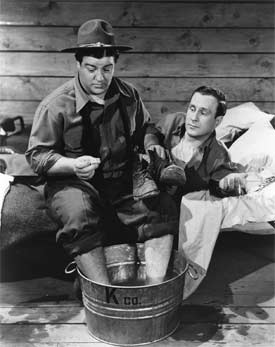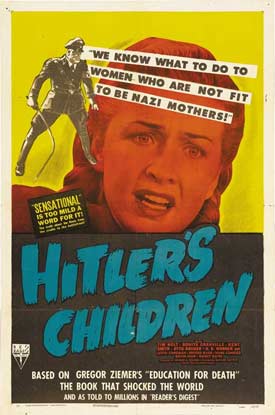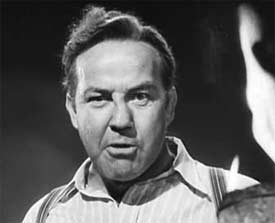
Movies in the 1940s, like everything else at the time, were dominated by the war. However, instead of facing shortages like most people, the industry was well supported by the government thanks to its morale boosting qualities.
The 1940s featured dozens of movies that were technological breakthroughs. Films like Citizen Cane, Casablanca and The Grapes of Wrath enamor filmmakers to this very day.
Jimmy Stewart was a huge star in the ’40s. I think “It’s A Wonderful Life” is one of the most moving performances I’ve ever seen.
Let’s break down the movie industry in the 1940s below, shall we?
Top 10 Movies in 1940
What were the most popular movies in 1940?
- Rebecca
- Boom Town
- The Great Dictator
- Strike Up The Band
- The Philadelphia Story
- Northwest Passage
- Andy Hardy Meets Debutante
- The Grapes of Wrath
- Kitty Foyle
- Comrade X
Who won the 1940 Academy Awards?
Best Picture: Rebecca
Best Director: John Ford – The Grapes of Wrath
Best Actress: Best Actress: Ginger Rogers – Kitty Foyle
Best Actor: James Stewart – The Philadelphia Story
Top 10 Movies in 1941
What were the most popular movies in 1941?
- Sergeant York
- Honky Tonk
- Louisiana Purchase
- A Yank in the RAF
- How Green Was My Valley
- Babes on Broadway
- Caught in the Draft
- Road to Zanzibar
- Keep ‘Em Flying
- In The Navy
Who won the 1941 Academy Awards?
Best Picture: How Green Was My Valley
Best Director: John Ford – How Green Was My Valley
Best Actress: Joan Fontaine – Suspicion
Best Actor: Gary Cooper – Sergeant York

Abbott & Costello were the hot newcomers of 1941
The government expected the motion picture industry to contribute strongly to national morale by means of unimpeded picture production.
1941 was a period of mounting box office receipts and uncertainties. The industry found itself harassed by political attack and confronted with problems of increased taxation and labor demands.
Anyone reading over the files of the motion picture trade press might learn how often “panic sweeps over the industry.” WWII brought problems that made competition from bowling alleys and nighttime baseball seem meaningless.
The movie industry in 1941 was often accused of war mongering. Many anti-war activists pointed toward movies that were designed to heighten American antagonism against the Axis powers.
Among the industry leaders were Nicholas Schneck, president of Loew’s Inc (MGM); Darryl Zanuck, VP of production at 20th Century Fox, Harry Warner, president of Warner Brothers and Barney Balaban, president of Paramount.
There was a strong trend toward comedy as evidenced by the success of Abbot & Costello and Bob Hope. Abbot & Costello were easily the newcomers of the year and their three pictures, Buck Privates, Hold That Ghost and Keep ‘Em Flying brought in a surprising amount of revenue.
Another trend leaned toward musicals and the sets were more elaborate and expensive in 1941 than ever before.
The three hottest newcomers were Rita Hayworth, Gene Tierney and Veronica Lake.
A number of Latin American pictures put out by Hollywood studios revolved around glamorous night life themes and were resented as giving a false impression of their habits and customs. Hollywood, showed an eagerness to learn and hired several technical engineers to help with the accuracy of their productions.
A feature of the movie industry’s role in war preparations was an extensive army training film program, with the studios and guilds participating without profit. The program was led by Darryl Zanuck, who had been appointed a lieutenant colonel in the army signal corps.
Actor James Stewart attracted the most attention when he was called to service by the selective service draft.
Top 10 Movies in 1942
What were the most popular movies in 1942?
- Mrs. Miniver
- Yankee Doodle Dandy
- Random Harvest
- Road to Morocco
- Reap the Wild Wind
- The Black Swan
- Somewhere I’ll Find You
- Holiday Inn
- Eagle Squadron
- The Pride of the Yankees
Who won the 1942 Academy Awards?
Best Picture: Mrs. Miniver
Best Director: William Wyler – Mrs. Miniver
Best Actress: Greer Garson – Mrs. Miniver
Best Actor: James Cagney – Yankee Doodle Dandy
Top 10 Movies in 1943
What were the most popular movies in 1943?
- For Whom the Bell Tolls
- This is the Army
- The Song of Bernadette
- Hitler’s Children
- Star Spangled Rhythm
- Casablanca
- Air Force
- Destination Tokyo
- A Guy Named Joe
- Coney Island
Who won the 1943 Academy Awards?
Best Picture: Casablanca
Best Director: Michael Curtiz – Casablanca
Best Actress: Jennifer Jones – The Song of Bernadette
Best Actor: Paul Lukas – Watch on the Rhine

Hitler’s Children was a surprise hit, considering it was made for $187
In 1943 more and more world-famous names disappeared from the marquees, as additional male stars went into the service.
Studios indulged in unusual co-operation to cope with the actor shortage, with loan-outs of stars and featured players increasing. More and more the play became the thing. Story prices went up as the stars departed. Best-sellers and stage hits were purchased at skyrocket heights.
Increase in production value was sought through the use of color, which had its biggest year. It was expected that color would be utilized even more after the war.
Indicative of the casting situation was the conclusion to be drawn from a study of Motion Picture Herald’s ten top money-making stars of 1942. Abbott & Costello, Clark Gable and Gene Autry were top-draw stars.
The Motion Picture Herald’s poll for 1943 found a woman at the top. Betty Grable, whose vehicles were Technicolor musical comedies. She was followed by Bob Hope, Abbott and Costello (the 1942 champions), Bing Crosby, Gary Cooper, Greer Garson, Humphrey Bogart, James Cagney, Mickey Rooney and Gable, who had a picture released before going into the army.
There were no pronounced movie trends during 1943.
Musicals were very popular, but a survey showed that public favor was not confined to any type of film.
The industry was again hit with protests that it was churning out too many war pictures. But here again the old rule held good. Some war pictures were stand-out hits, others flopped.
The most discussed pictures of the year were For Whom the Bell Tolls, This is the Army, The Song of Bernadette, Madame Curie and Victory Through Air Power.
Outstanding pictures of 1943
This Is The Army, Heaven Can Wait, For Whom the Bell Tolls, The Song of Bernadette, Madame Curie, So Proudly We Hail, Sweet Rosie O’Grady, Claudia, The Human Comedy, The More the Merrier, Watch on the Rhine, Behind the Rising Sun, Lassie Come Home, Shadow of a Doubt, Victory Through Air Power, The Ox-Bow Incident, Hitler’s Children, Guadalcanal Diary, Princess O’Rourke, Johnny Come Lately, Casablanca and Air Force.
Among the outstanding films also should be included a number of documentary pictures. Productions of this type attained a new importance in 1943, in some cases occupying a position on theater screens usually filled by a straight entertainment feature.
Outstanding documentaries were Desert Victory (British), Report from the Aleutians, Battle for Britain and Battle of Russia.
Battle-action documentaries were not obtained without risk and in some instances casualties in the photographic units ran high. The brave men & women who died to give us this footage should always be remembered.
I have a particular soft spot for documentaries. Frankly, I love them and, other than sports, its the only TV I watch. Thanks again to the documentarians in the 1940s that paved the way for us to learn so much than we ever could have without them.
Top 10 Movies in 1944
What were the most popular movies in 1944?
- Going My Way
- Wilson
- Since You Went Away
- Lady in the Dark
- Meet Me in St. Louis
- Mrs. Parkington
- Here Come the Waves
- The Story of Dr. Wassell
- Winged Victory
- Hollywood Canteen
Who won the 1944 Academy Awards?
Best Picture: Going My Way
Best Director: Leo McCarey – Going My Way
Best Actress: Ingrid Bergman – Gaslight
Best Actor: Bing Crosby – Going My Way
Top 10 Movies in 1945
What were the most popular movies in 1945?
- The Bells of St. Mary’s
- Spellbound
- Leave Her to Heaven
- Mildred Pierce
- Anchors Aweigh
- Week-End at the Waldorf
- Saratoga Trunk
- Thrill of a Romance
- The Valley of Decision
- Wonder Man
Who won the 1945 Academy Awards?
Best Picture: The Lost Weekend
Best Director: Billy Wilder – The Lost Weekend
Best Actress: Joan Crawford – Mildred Pierce
Best Actor: Ray Milland – The Lost Weekend
Top 10 Movies in 1946
What were the most popular movies in 1946?
- Song of the South
- The Best Years of Our Lives
- Duel in the Sun
- The Postman Always Rings Twice
- Blue Skies
- The Yearling
- The Razor’s Edge
- Notorious
- Till the Clouds Roll By
- Road to Utopia
Who won the 1946 Academy Awards?
Best Picture: The Best Years of Our Lives
Best Director: William Wyler – The Best Years of Our Lives
Best Actress: Olivia de Havilland – To Each His Own
Best Actor: Fredric March – The Best Years of Our Lives
Top 10 Movies in 1947
What were the most popular movies in 1947?
- Unconquered
- The Bachelor and the Bobby-Soxer
- The Egg and I
- Mother Wore Tights
- Green Dolphin Street
- Green Dolphin Street
- The Razor’s Edge
- Forever Amber
- Gentleman’s Agreement
- Cass Timberlane
Who won the 1947 Academy Awards?
Best Picture: Gentleman’s Agreement
Best Director: Elia Kazan – Gentleman’s Agreement
Best Actress: Loretta Young – The Farmer’s Daughter
Best Actor: Ronald Colman – A Double Life
Top 10 Movies in 1948
What were the most popular movies in 1948?
- The Red Shoes
- The Three Musketeers
- Red River
- The Treasure of the Sierra Madre
- When My Baby Smiles at Me
- Easter Parade
- Johnny Belinda
- The Snake Pit
- Joan of Arc
- Adventures of Don Juan
Who won the 1948 Academy Awards?
Best Picture: Hamlet
Best Director: John Huston – The Treasure of the Sierra Madre
Best Actress: Jane Wyman – Johnny Belinda
Best Actor: Laurence Olivier – Hamlet
Top 10 Movies in 1949
What were the most popular movies in 1949?
- Samson and Delilah
- Battleground
- Jolson Sings Again
- Sands of Iwo Jima
- I Was a Male War Bride
- Twelve O’Clock High
- A Letter to Three Wives
- The Heiress
- Pinky
- All the King’s Men
Who won the 1949 Academy Awards?
Best Picture: All the King’s Men
Best Director: Joseph L. Mankiewicz – A Letter to Three Wives
Best Actress: Olivia de Havilland – The Heiress
Best Actor: Broderick Crawford – All the King’s Men

Broderick Crawford was the critics’ favorite in 1949
In 1949 the outlook of the U.S. motion picture industry brightened perceptibly because it was becoming easier to make films of high quality, while spending less resources.
The industry’s morale may be said to have reached its lowest point in Feb. 1949, when only 22 pictures were under production in Hollywood, compared with a normal figure of nearly twice that number.
The industry had settled down to the task of reducing production expenditure. Under the sponsorship of the major studios, the Motion Picture Research council undertook continuous laboratory and experimental work. One development, a strippable adhesive for wallpaper used on film sets, resulted in a yearly saving of $40,000 per studio. Reduction in production costs generally was estimated at 20% to 25%.
Box-office returns for 1949 were estimated at $1.375 billion. The net profit estimate for seven major companies was $55 million, about the same as in 1948. Studio financial reports generally showed profits, though not always equal to those of 1948.
Some competition was felt by television, but not enough to make moviemakers worry.
The outstanding development in production trend in 1949 was concern with racial questions, following previous emphasis upon anti-Semitism. The situation of the African-American in the U.S. was dealt with in such films as Pinky, Intruder in the Dust, Lost Boundaries and The Home of the Brave.
A number of 1949’s pictures dealt with the war: Battleground, Twelve O’Clock High, The Hasty Heart, Task Force and Sands of Iwo Jima. Even the two highly successful comedies, I Was a Male War Bride and Francis, had war backgrounds.
Other outstanding movies were Jolson Sings Again, The Heiress, All the King’s Men, Champion, They Live by Night, Samson and Delilah and The Stratton Story. Some of the outstanding musical productions were The Barkleys of Broadway, Dancing in the Dark and On the Town.
New faces which attracted the most attention on the screen in 1949 were Kirk Douglas in Champion (which also introduced a new independent producer, Stanley Kramer), John Derek, Mercedes McCambridge, Keefe Brasselle and Richard Todd. Broderick Crawford, while not a newcomer, was acclaimed for his work in All the King’s Men.
Leading box-office stars of 1949
According to the annual poll of Motion Picture Herald, were Bob Hope, Bing Crosby (who had been first in the five preceding polls), Bud Abbott and Lew Costello, John Wayne, Gary Cooper, Cary Grant, Betty Grable, Esther Williams, Humphrey Bogart and Clark Gable.
Technical Developments
Several new color films were introduced in 1949. The Ansco process was further developed and received additional commercial use. A complete line of film types was now available for all the necessary steps from the original taking film up till the special effects steps to release prints.
Du Pont introduced a positive film for making three-color prints from separation negatives. This film was notable for employing a synthetic polymer which combined the functions of the gelatine and the color former usually employed.
Eastman introduced, on an experimental basis, a three-color negative and positive film of the single film, triple emulsion type. Tests on these films were in progress in Hollywood at the close of the year. Both Eastman and Du Pont continued experimenting with a negative film involving the use of three emulsions, two of which were subsequently stripped from the original base and mounted on new film bases in the laboratory before development.
Polacolor corporation introduced and employed commercially for a limited number of three-color cartoons a process using a standard single emulsion black-and-white positive film. It had to be printed in successive printing and developing processes from three-color separation negatives, and resulted in a three-color subtractive print.













At 84 I’m really enjoying browsing around your appealing website. Very well done! Like Oliver Twist, “I want some more” 🙂 Thank you for your efforts which I am certain echos many of us old-timers.
There seems to be a considerable gap in time between the end of 1943, when the world was buried at its deepest point fighting Axis oppression, tyranny and genocide, and the beginning of 1949, when the War had already been “won and done” for five full years, and the Post-War economy was in the midst of an upswing the likes of which we had never seen before, or would again.
Just as a “for instance” I should think the fact that incredibly talented and prolific film director William Wyler lost most of his hearing during flights over Europe during the War to produce military films, with his hearing unprotected, rendering him almost too deaf to continue working after the war, would be worth at least a passing mention. He did become a disabled veteran through his own efforts to do his job as well as he possibly could. Between his production of “Mrs. Miniver” in 1941-42 and “The Best Years of Our Lives” in 1946, he made no civilian films whatsoever – just documentary style educational films for the Army to use for education of the troops. Were it not for the innovative thinking of a cameraman on the project to produce “Best Years…” who devised a hearing amplification device that allowed Wyler to at least hear his actors, so that he could direct them, we might have all been denied one of the best films ever to be made.
Is there nothing more to be said about movie production and the many changes in focus, giving us, for example, the incredibly innovative genre of Film Noir, to follow the oh-so escapist themes produced during the War, and the upgrades in technical areas, as well as a few “back steps” that were taken during the rest of the War period, both in the US and elsewhere, and the rest of the decade leading up to the Fifties? That seems like a considerable gap to leave swinging wide open with nothing at all to fill it!
And I was surprised to see so much focus put on unfamiliar automobiles of foreign manufacture for so many time periods and categories after assuming that this was to cover primarily domestic issues, but then seeing so little of it in such a significant category. There were many automobiles of significance in all the categories and many of the decades, which get left out completely,
There’s quite a bit of social history covered here for any decade, in many categories. But still, I am finding significant gaps of time left uncovered in many of them. I realize that it takes considerable effort and study to compile the amount of information that has been posted. But it also seems like so much is left out, as well.
I am still enjoying what I do find here, and applaud your efforts. I hope to see more of it in the near future!
As a writer from generation X trying to write historical fiction, this is really helpful
What about casablanca